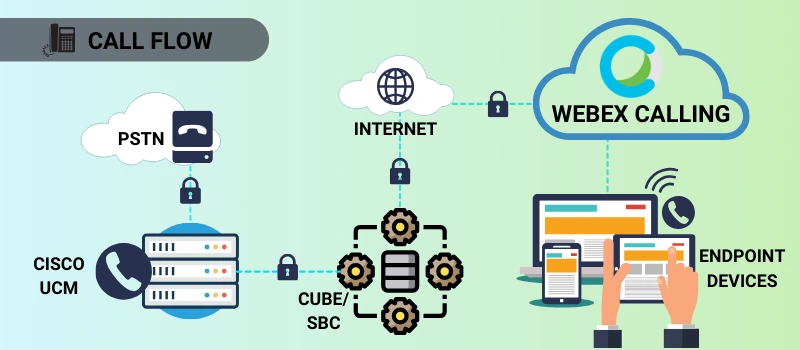


Webex Calling is a comprehensive cloud-based phone system that empowers organizations to make and receive calls from anywhere, using any device. By seamlessly integrating with the Webex collaboration platform, it offers a unified experience for all your communication needs.
| Feature | Description |
|---|---|
| Audio and Video Calls | Crystal-clear audio and HD video quality |
| Call Management | Hold, resume, transfer, and forwarding capabilities |
| Visual Voicemail | Easy access and management of voicemail messages |
| Directory Integration | Quick access to contacts with real-time presence information |
| Advanced Analytics | Real-time and historical data on call performance |
| Collaboration Tools | Screen sharing and whiteboarding during calls |
| Mobile Accessibility | Cross-device functionality for flexible remote work |
| Third-party Integrations | Connect with popular business applications |
| Security and Compliance | End-to-end encryption and compliance standards |
Webex Calling leverages cloud technology to provide users with enterprise-grade calling features, allowing businesses to replace their on-premise PBX system with a more flexible and scalable solution. Users can make calls directly from the Webex App, available on desktop, mobile, and web platforms.
Webex Calling is a cloud-based Voice over Internet Protocol (VoIP) technology. It utilizes Session Initiation Protocol (SIP) for calling and Real-time Transport Protocol (RTP) for media transmission.
When a user places a call through the Webex App or a compatible IP phone, the call is securely routed through Cisco's cloud infrastructure. The system employs advanced call control mechanisms to manage features such as call forwarding, voicemail, and conferencing.
For external calls, Webex Calling interfaces with the Public Switched Telephone Network (PSTN) either through local gateways or cloud-based PSTN connectivity options, utilizing SIP trunking for efficient call handling.
Webex Calling is built on Cisco's global cloud infrastructure, utilizing strategically located data centers across multiple regions. This design ensures redundancy and low-latency access for users worldwide. At its core, Webex Calling is powered by a cloud-native implementation of Cisco's Unified Communications Manager (UCM) technology, providing a robust foundation for its features.
Webex Calling employs standard VoIP protocols for its operations:
SIP (Session Initiation Protocol): Handles call signaling and setup
RTP (Real-time Transport Protocol): Manages media transmission
SRTP (Secure Real-time Transport Protocol): Ensures encrypted media transfer
When a user initiates a call through the Webex App or a compatible IP phone, the system uses these protocols to establish and maintain the connection securely through Cisco's cloud infrastructure.
Cisco is known for their top security features, and Webex Calling was designed with end-to-end encryption. The system implements end-to-end encryption by default for all Cisco endpoints and Calling clients, covering:
Encrypted phone registration
Encrypted call signaling
Encrypted audio and video streams
Encrypted voicemail
Webex Calling uses TLS (Transport Layer Security) for secure signaling and SRTP for media encryption, ensuring that all communications remain confidential.
Additional Security Features of Webex Calling:
Highly secure, compliant data centers with 24/7 onsite security
Secure device configuration
Key Management Service (KMS) for cryptographic key management
Customizable security controls
Regional data storage options
Domain verification for proper Hybrid Services functionality
For external calls, Webex Calling interfaces with the Public Switched Telephone Network (PSTN) through two primary methods:
Cloud Connect: Utilizes Cisco-certified PSTN providers in over 60 markets globally
Local Gateway: Allows customers to use existing PSTN providers in more than 160 markets
Both options employ SIP trunking for efficient call handling and seamless integration with the cloud infrastructure.

To optimize call quality and reduce latency, Webex Calling uses ICE (Interactive Connectivity Establishment) for media path optimization. This allows for direct media paths between endpoints when possible.
Cisco IP Phones (6800, 7800, and 8800 Series)
Webex Desk Devices and Room Systems
Specialized devices (DECT phones, ATAs)
Select third-party IP phones
Both options employ SIP trunking for efficient call handling and seamless integration with the cloud infrastructure.
Webex Calling provides a comprehensive set of APIs for integration and customization. The system is managed through the centralized Control Hub, which offers user and device provisioning, feature configuration, analytics, reporting, and troubleshooting tools.
Real-time calling APIs for soft-phone experiences
Device management APIs
Feature configuration APIs
Reporting and analytics APIs
For enterprises with specific requirements, Webex Calling offers a Dedicated Instance option. This provides a dedicated cloud instance based on Cisco Unified Communications Manager architecture, offering additional customization and support for legacy integrations.
Putting it head-to-head with Microsoft Teams, Webex Calling expands it's calling features to also include collaboration tools perfect for internal or external communication. Some of it's features include:
Click to Switch Communication Methods: Escalate chat conversations to voice or video calls with a single click
Share Your Screen: Collaborate on documents or presentations during calls
Whiteboard's: Use the integrated whiteboard feature for real-time visual collaboration and brainstorming sessions with your team
3rd Party Integrations Webex hosts the Webex App Hub that invites 3rd party tools that integrate with their platform to give customers even more options.
Be sure to check out Expo XT on the Webex App Hub!
While the cloud has tons of inviting features, not every business is ready to abandon their Cisco UCM, thus, Webex Hybrid Calling. For organizations looking to maintain their existing infrastructure while embracing cloud capabilities, Webex Hybrid Calling offers the perfect solution. It allows organizations to keep their Cisco Unified Communications Manager (UCM) but incorporate Webex services to get the access to expanded features. It also gives enterprises more time to switch over their complex voice networks.
Cloud-based communication, all-in-one platforms, and AI automation is the way the world is heading, and Webex Calling is spearheading the change. By leveraging the power of cloud technology and integrating seamlessly with other collaboration tools, Webex Calling provides a flexible, secure, and feature-rich solution for modern business communication needs. Whether you're a small business or a large enterprise, Webex Calling can help streamline your communication processes and enhance team collaboration.
<